Hello Insect lovers
Saludos mis amigos de la plataforma de Hive, en especial a los amantes del mundo de los insectos, les doy una vez más la bienvenida a mi nuevo post, el cuál será mi nueva entrada al maravilloso concurso de Agosto 2021 - #04 de la comunidad de Insectos del Mundo, patrocinado y realizado por @adalger. ¡Así que si queréis saber más, mejor no os vayáis, ya que este nuevo insecto del que os hablaré es un escarabajo muy hermoso, pequeño y con una familia ¡tan enorme que supera a los mamíferos con más de 66 especies en todo el mundo!
Greetings my friends of the Hive platform, especially to the lovers of the insect world, I welcome you once again to my new post, which will be my new entry to the wonderful August 2021 - #04 contest of the Insects of the World community, sponsored and made by @adalger. So if you want to know more, you better not go away, as this new insect I will tell you about is a very beautiful beetle, small and with such a huge family that surpasses mammals with more than 66 species worldwide!
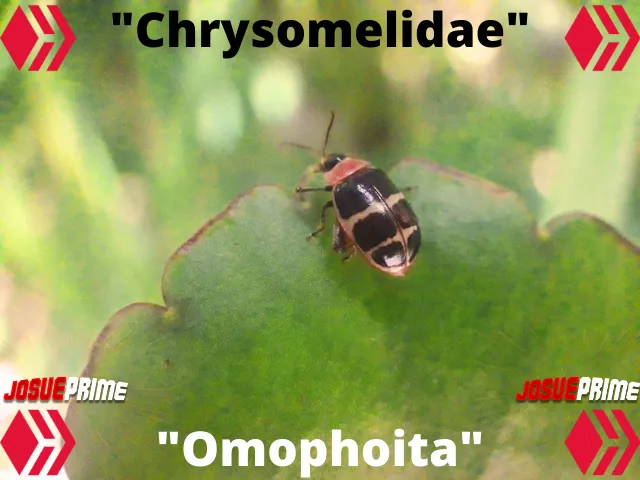
Como todos sabrán hay una gran diversidad de la clase “Insecta” que habitan en todo el mundo, con más de 1 Millón de especies, se les conoce comúnmente como Insectos los cuales son una división de animales “Invertebrados” de la categoría de los muchos artrópodos, las características que presentan son dos pares de alas, un par de antenas y tres pares de patas, aunque algunas veces puede reducirse o faltarle algunas de estas características nombradas anteriormente. Algunas veces estos insectos van cambiando de apariencia o hábitat debido a que evolucionan para así adaptarse fácilmente a los diferentes entornos.
As you all know there is a great diversity of the class "Insecta" that inhabit all over the world, with more than 1 Million species, they are commonly known as Insects which are a division of animals "Invertebrates" of the category of the many arthropods, the characteristics they present are two pairs of wings, a pair of antennae and three pairs of legs, although sometimes it can be reduced or lack some of these characteristics named above. Sometimes these insects change their appearance or habitat as they evolve to adapt easily to different environments.

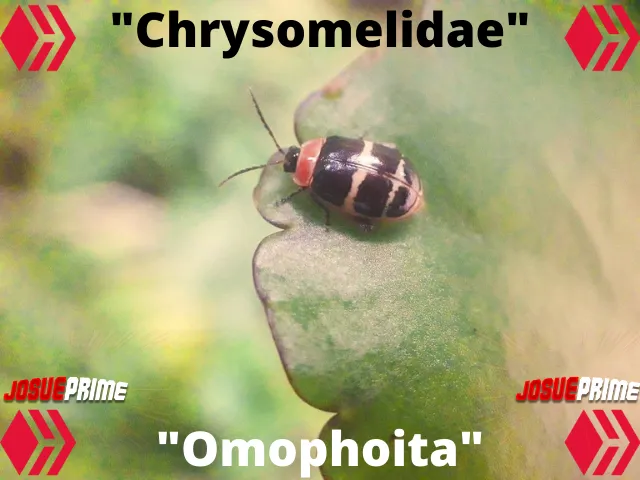
Los escarabajos son unos de los insectos que podemos apreciar desde el más pequeño hasta el más grande y fuerte, ya sea pequeño como la Mariquita conocida por tener unos colores demasiados hermosos y llamativos, o sea grande como el escarabajo Goliat que tienen una gran fuerza, colores hermosos y un sonido que producen con sus alas al volar parecido al de un helicóptero. En esta ocasión el escarabajo que yo vengo a enseñarles es pequeño y hermoso, es conocido por su nombre científico: “Omophoita” siendo del grupo de “escarabajos pulgas” y de la gran familia “Chrysomelidae”, se le reconoce por el nombre escarabajos de las hojas y como lo dice su nombre habitan en las hojas y tallos de las plantas de las cuales se alimentan y viven.
Beetles are some of the insects that we can appreciate from the smallest to the largest and strongest, either small as the Ladybug known for having too many beautiful and striking colors, or large as the Goliath beetle that have great strength, beautiful colors and a sound they produce with their wings to fly like a helicopter. This time the beetle that I come to show you is small and beautiful, it is known by its scientific name: "Omophoita" being of the group of "flea beetles" and of the great family "Chrysomelidae", it is recognized by the name of leaf beetles and as its name says they inhabit the leaves and stems of the plants on which they feed and live.

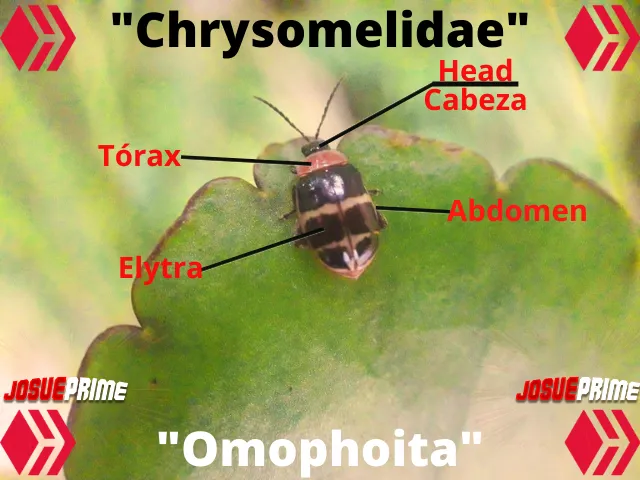
Este pequeño escarabajo de las hojas así como todos los demás escarabajos que existen, tienen un par de élitros que son las alas anteriores, las cuales son muy duras y les sirven como protección de las alas posteriores, suelen usar estos élitros para planear durante unos microsegundos mientras descansan las alas que están debajo. Como todo otro insecto, este también tiene las 3 regiones que componen su cuerpo (cabeza, tórax y abdomen). Dependiendo el tipo de especie del escarabajo “Omophoita” sus alas endurecidas pueden tener colores y formas diferentes, ya sean: Círculos o franjas blancas con negro, rojo, anaranjado o marrón.
This small leaf beetle as well as all other beetles that exist, have a pair of elytra which are the anterior wings, which are very hard and serve as protection of the hind wings, usually use these elytra to glide for a few microseconds while resting the wings that are below. Like any other insect, this one also has the 3 regions that compose its body (head, thorax and abdomen). Depending on the type of species of the beetle "Omophoita" its hardened wings can have different colors and shapes, either: White circles or stripes with black, red, orange or brown.

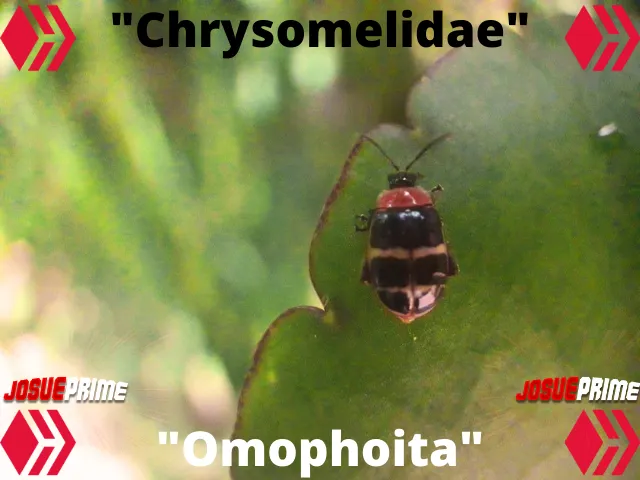
Los escarabajos que estamos acostumbrado a ver mucho son más grandes que este, en cambio cuando el escarabajo “Omophoita” está en el estado de larva tienen un tamaño mucho más pequeño del que tiene ahora en la fase adulta. Este escarabajo de las hojas tiene un tamaño calculado en milímetros y no en centímetros debido que es muy pequeño, imagínense poder verlo en el estado de larva sería mucho más pequeño que un gusano de guayaba.
The beetles that we are used to see a lot are bigger than this one, but when the "Omophoita" beetle is in the larva stage they have a much smaller size than it has now in the adult stage. This leaf beetle has a size calculated in millimeters and not in centimeters because it is very small, imagine being able to see it in the larva stage would be much smaller than a guava worm.

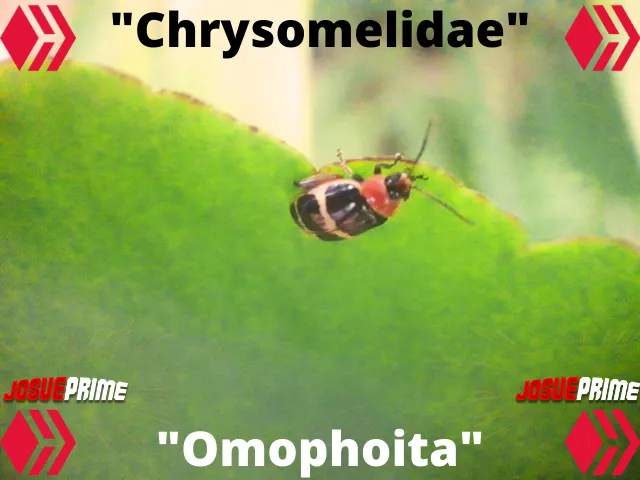
Lo más increíble y llamativo es que este escarabajo tan pequeño se le considera una gran amenaza para los cultivos de los sembradores de verduras, frutas y hortalizas, ya que se alimentan de las flores y hojas de las plantas, haciendo que la planta se marchite y se seque aunque reciba la luz del sol y riego de agua constante. Esto no quiere decir que debemos matar a este pequeño escarabajo ya que también es un gran ayudante que suele quitar las otras plagas que dañan las plantas.
The most incredible and striking thing is that this very small beetle is considered a great threat to the crops of vegetable growers, fruits and vegetables, as they feed on the flowers and leaves of plants, causing the plant to wither and dry even if it receives sunlight and constant water irrigation. This does not mean that we should kill this little beetle as it is also a great helper that usually removes the other pests that damage plants.


La naturaleza es increíble y nos sorprendes cada vez más con los nuevos insectos y especies que podemos encontrar en nuestro entorno, algo bastante importante son los insectos ya que tienen funciones esenciales en muchos ecosistemas como: polinizar las flores y airean el suelo, o como algunos de los escarabajos de las hojas que aunque tengan un tamaño pequeño pueden espantar a las demás plagas que dañan las platas o como los escarabajos rinoceronte que hacen una gran materia orgánica con descomposición de animales ya sea cadáveres o excremento. ¡Recuerda proteger el planeta y cuidar la naturaleza, para así tener un hermoso ecosistema!
Nature is amazing and surprises us more and more with new insects and species that we can find in our environment, something quite important are the insects as they have essential functions in many ecosystems such as: pollinate flowers and aerate the soil, or as some of the leaf beetles that although they have a small size can scare other pests that damage the plants or as rhinoceros beetles that make a great organic matter with decomposition of animals either corpses or excrement. Remember to protect the planet and take care of nature, in order to have a beautiful ecosystem!

Espero les haya gustado mi breve explicación informativa de este hermoso y pqueño insecto, estas fotos las he tomado con un Samsung J7 y una lupa. Comenta que te pareció este post, nos vemos en mis próximas publicaciones. ¡¡Hasta Pronto.!!
I hope you liked my brief informative explanation of this beautiful and small insect, these photos were taken with a Samsung J7 and a magnifying glass. Comment what you thought about this post, see you in my next publications. See you soon!
Todo lo que esta escrito en este post fue analizado por mi mismo de lo que investigue acerca del los escarabajos en especial el "Omophoita". Si quieres saber más, te dejo la fuente donde yo he investigado acerca de este hermoso escarabajo pequeño: https://en.wikipedia.org/wiki/Omophoita
https://es.wikipedia.org/wiki/Coleoptera
https://es.wikipedia.org/wiki/Chrysomelidae
Everything that is written in this post was analyzed by myself from what I researched about the beetles especially the "Omophoita". If you want to know more, I leave you the source where I have researched about this beautiful small beetle: https://en.wikipedia.org/wiki/Omophoita
https://es.wikipedia.org/wiki/Coleoptera
https://es.wikipedia.org/wiki/Chrysomelidae
Todas las imágenes y fotografías que subo, a no ser que especifique lo contrario, están hechas y son de mi propiedad. @josueprime contenido original.
All images and photographs I upload, unless I specify otherwise, are made and owned by me. @josueprime highly original content.

